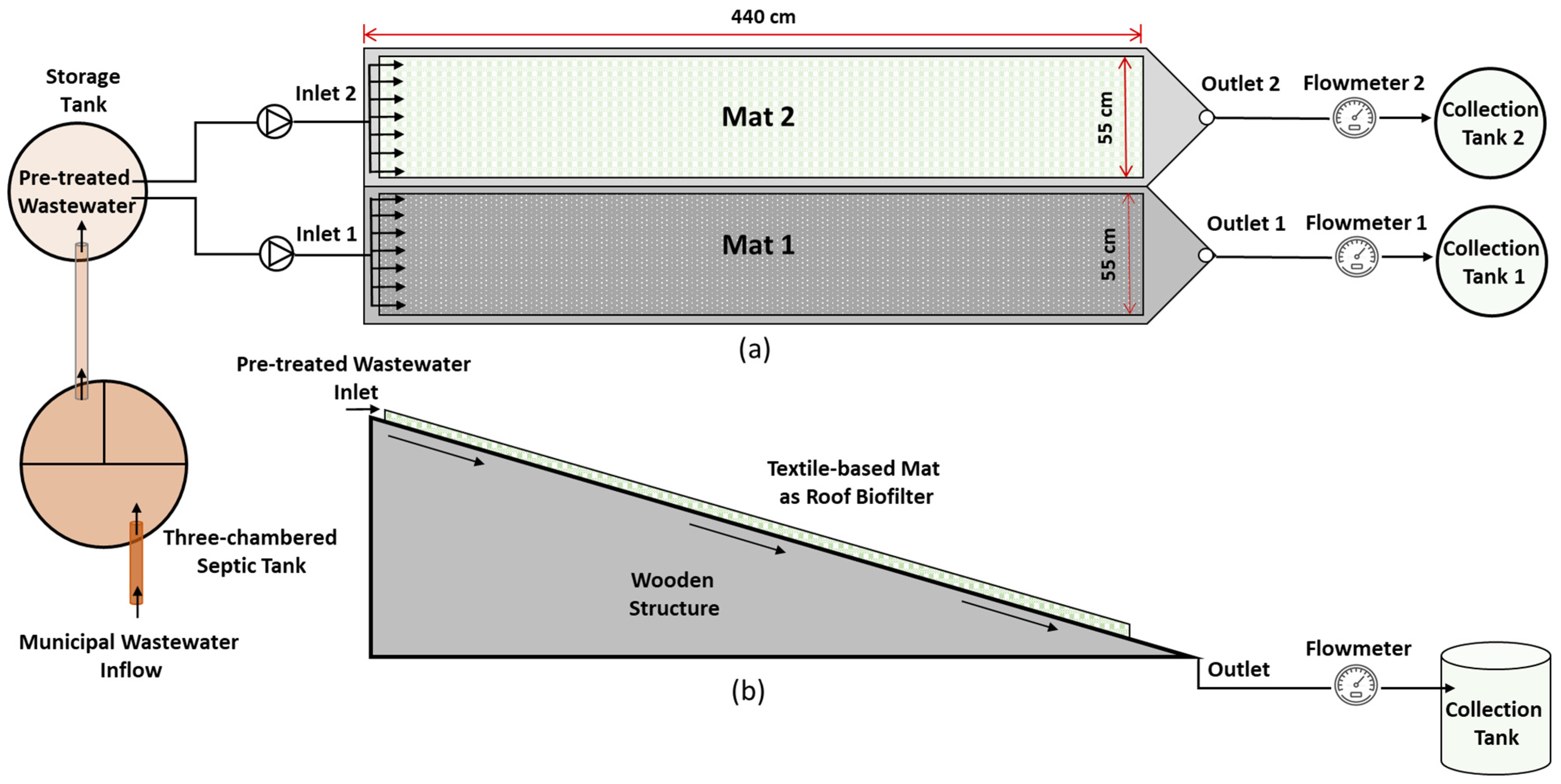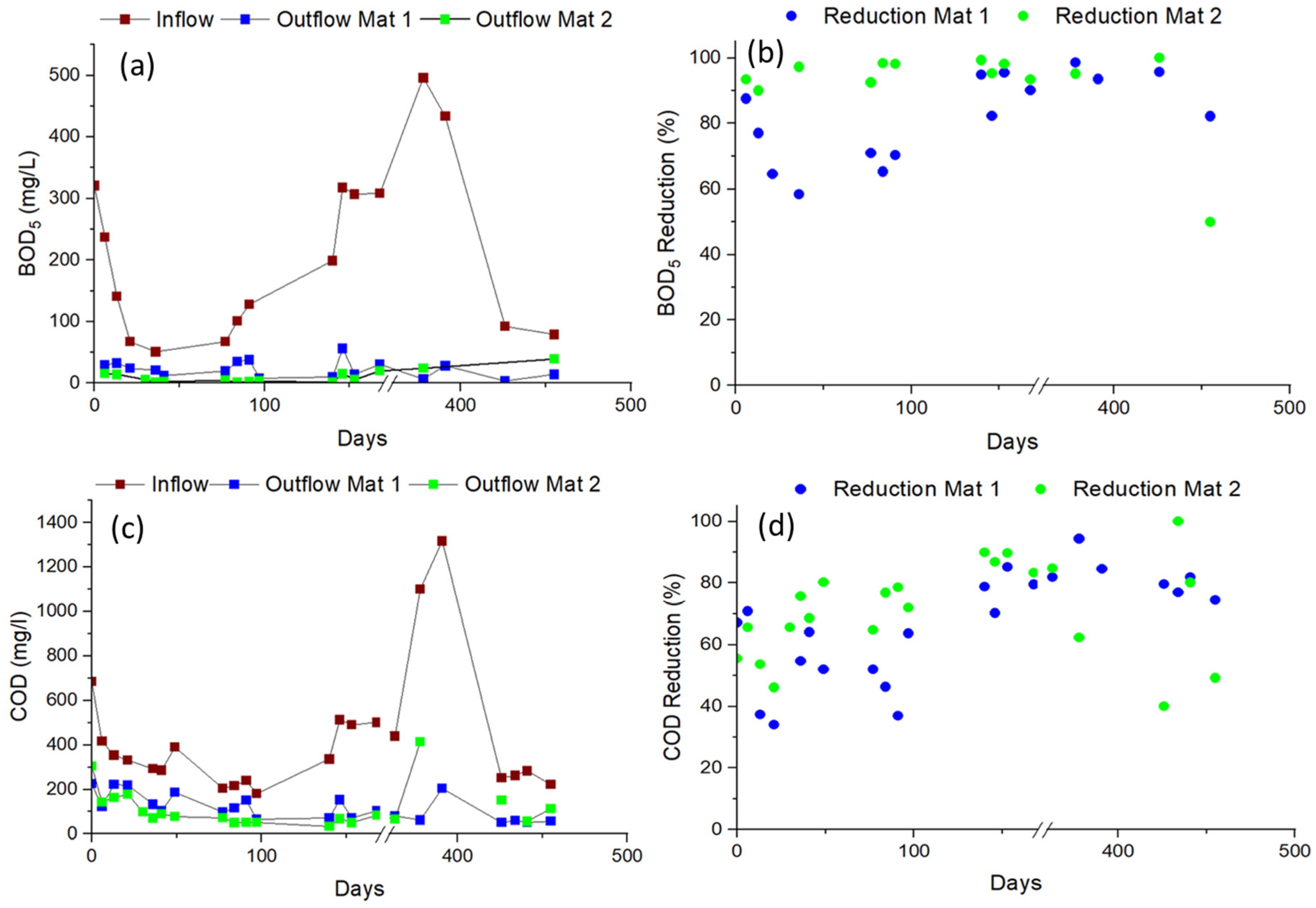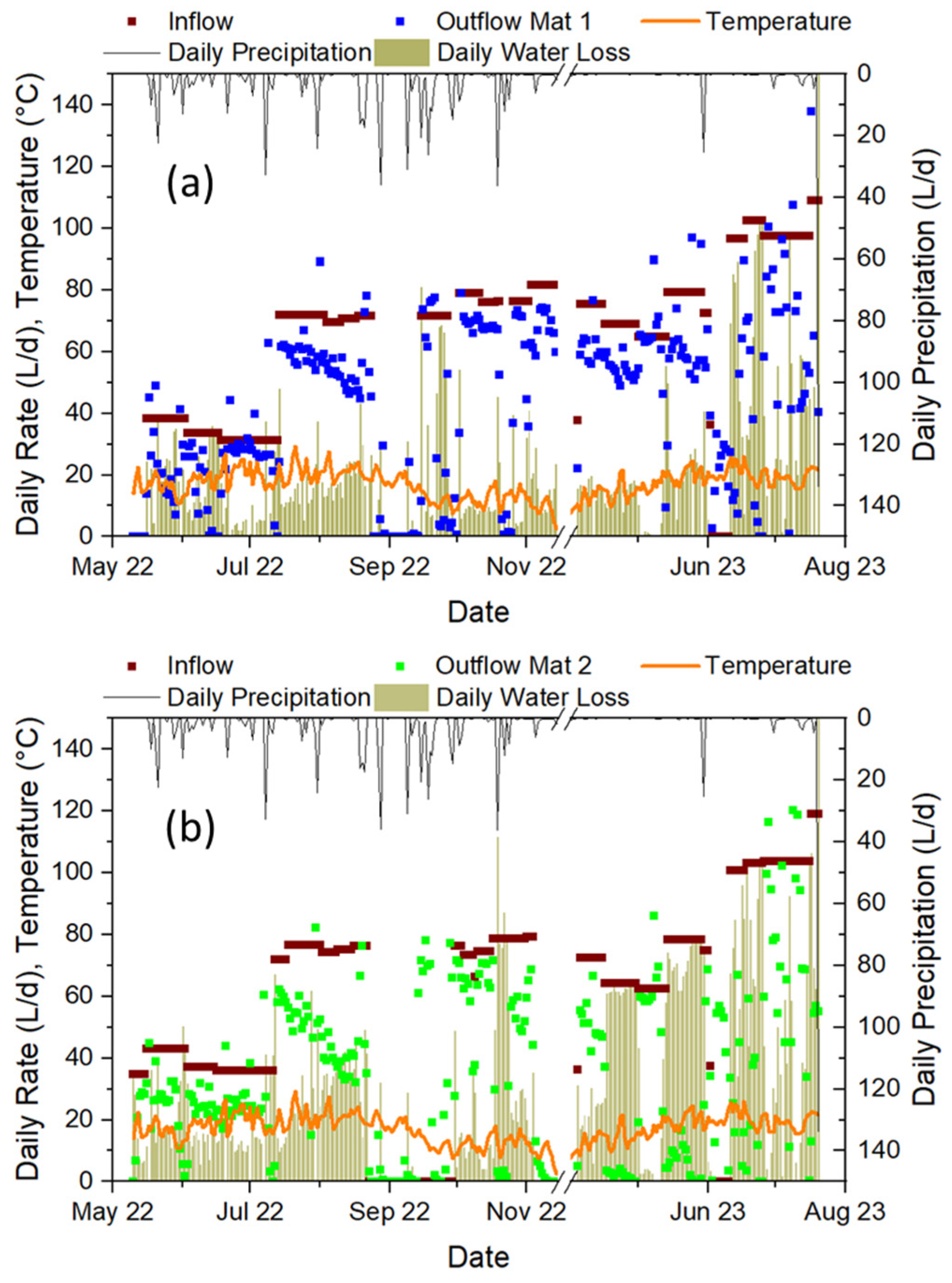Performance of Textile-Based Water-Storage Mats in Treating Municipal Wastewater on Urban Rooftops for Climate-Resilient Cities
Abstract
1. Introduction
2. Materials and Methods
2.1. Site Description
2.2. Experimental Design: Pilot Plant Description
2.3. Experimental Conditions and Operation of the Pilot Plant
2.4. Sampling Campaigns and Analysis
2.5. Data Analysis and Statistical Methods
3. Results and Discussion
3.1. Overall Treatment Performance of the Mats
3.1.1. Variations in pH, Eh, EC, DO, TU, and TSS
3.1.2. BOD5 and COD
3.1.3. NH4-N, NO3-N, TN, and TP
3.1.4. E. coli
3.2. Weather Conditions and Water Loss
3.3. Role of Plants on Water Quality
3.4. Potential Applications, Challenges, and Practical Recommendations
4. Conclusions
Author Contributions
Funding
Data Availability Statement
Acknowledgments
Conflicts of Interest
References
- United Nations. World Urbanization Prospects; United Nations: New York, NY, USA, 2014. [Google Scholar]
- United Nations Department of Economic and Social Affairs. World Urbanization Prospects 2018: Highlights; UN: New York, NY, USA, 2019. [Google Scholar]
- IPCC. Climate Change 2014. In Synthesis Report, Summary for Policymakers; IPCC: Geneva, Switzerland, 2014. [Google Scholar]
- Jochner, S.; Alves-Eigenheer, M.; Menzel, A.; Morellato, L.P.C. Using phenology to assess urban heat islands in tropical and temperate regions. Int. J. Climatol. 2013, 33, 3141–3151. [Google Scholar] [CrossRef]
- Mora, C.; Dousset, B.; Caldwell, I.R.; Powell, F.E.; Geronimo, R.C.; Bielecki, C.R.; Counsell, C.W.; Dietrich, B.S.; Johnston, E.T.; Louis, L.V. Global risk of deadly heat. Nat. Clim. Change 2017, 7, 501–506. [Google Scholar] [CrossRef]
- Li, D.; Bou-Zeid, E. Synergistic interactions between urban heat islands and heat waves: The impact in cities is larger than the sum of its parts. J. Appl. Meteorol. Climatol. 2013, 52, 2051–2064. [Google Scholar] [CrossRef]
- Huang, K.; Li, X.; Liu, X.; Seto, K.C. Projecting global urban land expansion and heat island intensification through 2050. Environ. Res. Lett. 2019, 14, 114037. [Google Scholar] [CrossRef]
- Qadir, M.; Sharma, B.R.; Bruggeman, A.; Choukr-Allah, R.; Karajeh, F. Non-conventional water resources and opportunities for water augmentation to achieve food security in water scarce countries. Agric. Water Manag. 2007, 87, 2–22. [Google Scholar] [CrossRef]
- Qasim, S.R.; Zhu, G. Wastewater treatment and reuse: Theory and design examples. In Principles and Basic Treatment; CRC Press: Boca Raton, FL, USA, 2017; Volume 1. [Google Scholar] [CrossRef]
- Friedler, E.; Hadari, M. Economic feasibility of on-site greywater reuse in multistorey buildings. Desalination 2006, 190, 221–234. [Google Scholar] [CrossRef]
- Liu, W.; Wei, W.; Chen, W.; Deo, R.C.; Si, J.; Xi, H.; Li, B.; Feng, Q. The impacts of substrate and vegetation on stormwater runoff quality from extensive green roofs. J. Hydrol. 2019, 576, 575–582. [Google Scholar] [CrossRef]
- Liu, L.; Cao, J.; Ali, M.; Zhang, J.; Wang, Z. Impact of green roof plant species on domestic wastewater treatment. Environ. Advances. 2021, 4, 100059. [Google Scholar] [CrossRef]
- Wooster, E.I.F.; Fleck, R.; Torpy, F.; Ramp, D.; Irga, P.J. Urban green roofs promote metropolitan biodiversity: A comparative case study. Build. Environ. 2022, 207, 108458. [Google Scholar] [CrossRef]
- Bevilacqua, P. The effectiveness of green roofs in reducing building energy consumptions across different climates. A summary of literature results. Renew. Sustain. Energy Rev. 2021, 151, 111523. [Google Scholar] [CrossRef]
- Jungels, J.; Rakow, D.A.; Allred, S.B.; Skelly, S.M. Attitudes and aesthetic reactions toward green roofs in the northeastern United States. Landsc. Urban Plan. 2013, 117, 13–21. [Google Scholar] [CrossRef]
- Rafael, S.; Correia, L.P.; Ascenso, A.; Augusto, B.; Lopes, D.; Miranda, A.I. Are green roofs the path to clean air and low carbon cities? Sci. Total. Environ. 2021, 798, 149313. [Google Scholar] [CrossRef]
- Motlagh, S.H.B.; Pons, O.; Hosseini, S.M.A. Sustainability model to assess the suitability of green roof alternatives for urban air pollution reduction applied in Tehran. J. Affect. Disord. 2021, 194, 107683. [Google Scholar]
- Feitosa, R.C.; Wilkinson, S.J. Attenuating heat stress through green roof and green wall retrofit. J. Affect. Disord. 2018, 140, 11–22. [Google Scholar]
- Yan, J.; Yang, P.; Wang, B.; Wu, S.; Zhao, M.; Zheng, X.; Wang, Z.; Zhang, Y.; Fan, C. Green Roof Systems for Rainwater and Sewage Treatment. Water 2024, 16, 2090. [Google Scholar] [CrossRef]
- Zehnsdorf, A.; Blumberg, M.; Müller, R.A. Helophyte mats (wetland roofs) with high evapotranspiration rates as a tool for decentralized rainwater management—Process stability improved by simultaneous greywater treatment. Water Sci. Technol. Water Supply 2019, 19, 808–814. [Google Scholar] [CrossRef]
- Zehnsdorf, A.; Willebrand, K.C.U.; Trabitzsch, R.; Knechtel, S.; Blumberg, M.; Müller, R.A. Wetland Roofs as an Attractive Option for Decentralized Water Management and Air Conditioning Enhancement in Growing Cities—A Review. Water 2019, 11, 1845. [Google Scholar] [CrossRef]
- Kader, S.; Chadalavada, S.; Jaufer, L.; Spalevic, V.; Dudic, B. Green roof substrates—A literature review. Front. Built Environ. 2022, 8, 1019362. [Google Scholar] [CrossRef]
- Narkhede, H.I.; Deokar, B.K.; Kardile, D.S.; Handore, A.V.; Surana, A.R. Cocopeat Biofilters: A sustainable approach for water purification and nutrient management. Separat. Purificat. Technol. 2025, 353, 128558. [Google Scholar] [CrossRef]
- Zehnsdorf, A.; Stock, N.; Richter, J.; Blumberg, M.; Müller, R.A. Grauwasserreinigung mit einer Sumpfpflanzenmatte unter Praxisbedingungen. Chem. Ing. Technol. 2016, 88, 1138–1144. (In German) [Google Scholar] [CrossRef]
- Abdalla, E.M.H.; Alfredsen, K.; Muthanna, T.M. Impacts of slope and length on the hydrological performance of green roof drainage mats. J. Hydrol. 2024, 632, 130974. [Google Scholar] [CrossRef]
- Rahman, K.Z.; Al Saadi, S.; Al Rawahi, M.; Knappe, J.; van Afferden, M.; Moeller, L.; Bernhard, K.; Müller, R.A. A multi-functional nature-based solution (NBS) for greywater treatment and reuse at the same plot. Ecol. Eng. 2023, 191, 106952. [Google Scholar] [CrossRef]
- Rahman, K.Z.; Al Saadi, S.; Al Rawahi, M.; van Afferden, M.; Bernhard, K.; Friesen, J.; Müller, R.A. Small Decentralized Technologies for High-Strength Wastewater Treatment and Reuse in Arid and Semi-Arid Regions. Environments 2024, 11, 142. [Google Scholar] [CrossRef]
- EN ISO 11732; Water Quality—Determination of Ammonium Nitrogen—Method by Flow Analysis (CFA and FIA) and Spectrometric Detection. ISO: London, UK, 2005.
- EN ISO 10304-1; Water Quality—Determination of Dissolved Anions by Liquid Chromatography of Ions—Part 1: Determination of Bromide, Chloride, Fluoride, Nitrate, Nitrite, Phosphate and Sulfate. ISO: London, UK, 2007.
- EN ISO 15681-1; Water Quality—Determination of Orthophosphate and Total Phosphorus Contents by Flow Analysis (FIA and CFA)—Part 1: Method by Flow Injection Analysis (FIA). ISO: London, UK, 2003.
- DIN 38409-1; German Standard Methods for the Examination of Water, Waste Water and Sludge; Parameters Characterizing Effects and Substances (group H); determination of total dry residue, filtrate dry residue and residue on ignition (H 1). DIN Standards Committee Water Practice: Berlin, Germany, 1987.
- ISO 9308-2; Water Quality—Enumeration of Escherichia coli and Coliform Bacteria—Part 2: Most Probable Number Method. ISO: London, UK, 2012.
- DWA-A 221; Principles for the Use of Small Sewage Treatment Plants; DWA Set of Rules. The German Association for Water, Wastewater and Waste (DWA): Hennef, Germany, 2019; ISBN 978-3-88721-911-6.
- European Union. Regulation (EU) 2020/741 of the European Parliament and of the Council 25 May 2020 on Minimum Requirements for Water Reuse. Off. J. Eur. Union 2020, OJ L 177, 32–55. Available online: https://eur-lex.europa.eu/legal-content/EN/TXT/PDF/?uri=CELEX:32020R0741&from=EN (accessed on 20 June 2025).
- Saeed, T.; Sun, G. A review on nitrogen and organics removal mechanisms in subsurface flow constructed wetlands: Dependency on environmental parameters, operating conditions and supporting media. J. Environ. Manag. 2012, 112, 429–448. [Google Scholar] [CrossRef] [PubMed]
- Bezbaruah, A.N.; Zhang, T.C. Quantification of oxygen release by bulrush (Scirpus validus) roots in a constructed treatment wetland. Biotechnol. Bioeng. 2005, 89, 308–318. [Google Scholar] [CrossRef]
- Wu, H.; Zhang, J.; Ngo, H.H.; Guo, W.; Hu, Z.; Liang, S.; Fan, J.; Liu, H. A review on the sustainability of constructed wetlands for wastewater treatment: Design and operation. Bioresour. Technol. 2015, 175, 594–601. [Google Scholar] [CrossRef] [PubMed]
- Zeng, R.J.; Lemaire, R.; Yuan, Z.; Keller, J. Simultaneous Nitrification, Denitrification, and Phosphorus Removal in a Lab-Scale Sequencing Batch Reactor. Biotechnol. Bioeng. 2003, 84, 170–178. [Google Scholar] [CrossRef]
- Nivala, J.; Wallace, S.; Headley, T.; Kassa, K.; Brix, H.; van Afferden, M.; Müller, R. Oxygen transfer and consumption in subsurface flow treatment wetlands. Ecol. Eng. 2013, 61, 544–554. [Google Scholar] [CrossRef]
- Han, Y.; Lu, X.; Liu, Y.; Deng, Y.; Zan, F.; Mao, J.; Hao, T.; Cao, C.; Wu, X. Achieving superior nitrogen removal in an air-lifting internal circulating reactor for municipal wastewater treatment: Performance, kinetic analysis, and microbial pathways. Bioresour. Technol. 2023, 371, 128599. [Google Scholar] [CrossRef]
- Pradhan, S.; Al-Ghamdi, S.G.; Mackey, H.R. Greywater recycling in buildings using living walls and green roofs: A review of the applicability and challenges. Sci. Total. Environ. 2019, 652, 330–344. [Google Scholar] [CrossRef] [PubMed]
- Tondera, K.; Klaer, K.; Gebhardt, J.; Wingender, J.; Koch, C.; Horstkott, M.; Strathmann, M.; Jurzik, L.; Hamza, I.; Pinnekamp, J. Reducing pathogens in combined sewer overflows using ozonation or UV irradiation. Int. J. Hyg. Environ. Health 2015, 218, 731–741. [Google Scholar] [CrossRef] [PubMed]
- Rahman, K.Z.; Chen, X.; Blumberg, M.; Bernhard, K.; Müller, R.A.; Mackenzie, K.; Trabitzsch, R.; Moeller, L. Effect of Hydraulic Loading Rate on Treatment Performance of a Pilot Wetland Roof Treating Greywater from a Household. Water 2023, 15, 3375. [Google Scholar] [CrossRef]
- Lak, Z.A.; Sandén, H.; Mayer, M.; Rewald, B. Specific root respiration of three plant species as influenced by storage time and conditions. Plant Soil 2020, 453, 615–626. [Google Scholar] [CrossRef]
- Ben-Noah, I.; Friedman, S.P. Review and evaluation of root respiration and of natural and agricultural processes of soil aeration. Vadose Zone J. 2018, 17, 170119. [Google Scholar] [CrossRef]
- Kurosawa, Y.; Mori, S.; Ferrio, J.P.; Nishizono, T.; Masyagina, O.V.; Yamaji, K.; Koyama, K.; Haruma, T.; Doyama, K.; Hoshino, T.; et al. Scaling of shoot and root respiration of woody and herbaceous plants. Proc. R. Soc. B 2025, 292, 20241910. [Google Scholar] [CrossRef]
- Piwpuan, N.; Zhai, X.; Brix, H. Nitrogen nutrition of Cyperus laevigatus and Phormium tenax: Effects of ammonium versus nitrate on growth, nitrate reductase activity and N uptake kinetics. Aquat. Bot. 2013, 106, 42–51. [Google Scholar] [CrossRef]
- Thi-Dieu-Hien, V.; Thi-Bich-Ngoc, D.; Xuan-Thanh, B.; Van-Truc, N.; Dinh-Duc, N.; Sthiannopkao, S.; Lin, C. Improvement of septic tank effluent and green coverage by shallow bed wetland roof system. Int. Biodeter. Biodegr. 2017, 124, 138–145. [Google Scholar]
- Chaudhary, V.B.; Sandall, E.L.; Lazarski, M.V. Urban mycorrhizas: Predicting arbuscular mycorrhizal abundance in green roofs. Fungal Ecol. 2019, 40, 12–19. [Google Scholar] [CrossRef]
- Wu, H.; Wang, R.; Yan, P.; Wu, S.; Chen, Z.; Zhao, Y.; Cheng, C.; Hu, Z.; Zhuang, L.; Guo, Z. Constructed wetlands for pollution control. Nat. Rev. Earth Environ. 2023, 4, 218–234. [Google Scholar] [CrossRef]
- Stottmeister, U.; Wießner, A.; Kuschk, P.; Kappelmeyer, U.; Kästner, M.; Bederski, O.; Müller, R.A.; Moormann, H. Effects of plants and microorganisms in constructed wetlands for wastewater treatment. Biotechnol. Adv. 2003, 22, 93–117. [Google Scholar] [CrossRef]
- Liu, Y.; Evans, S.E.; Friesen, M.L.; Tiemann, L.K. Root exudates shift how N mineralization and N fixation contribute to the plant-available N supply in low fertility soils. Soil Biol. Biochem. 2022, 165, 108541. [Google Scholar] [CrossRef]
- Thon, A.; Kircher, W.; Thon, I. Constructed Wetlands on Roofs as a Module of Sanitary Environmental Engineering to Improve Urban Climate and Benefit of the On-Site Thermal Effects. Miest. Zeldynu Formav. 2010, 1, 191–196. [Google Scholar]
- Zapater-Pereyra, M.; Lavrinc, S.; Van Dien, F.; Van Bruggen, J.J.A.; Lens, P.N.L. Constructed wetroofs: A novel approach for the treatment and reuse of domestic wastewater. Ecol. Eng. 2016, 94, 545–554. [Google Scholar] [CrossRef]
- Castro, A.S.; Goldenfum, J.A.; da Silveira, A.L.; Bertani DallAgnol, A.L.; Loebens, L.; Demarco, C.F.; Leandro, D.; Nadaleti, W.C.; Quadro, M.S. The analysis of green roof’s runoff volumes and its water quality in an experimental study in Porto Alegre, Southern Brazil. Environ. Sci. Pollut. R. 2020, 27, 9520–9534. [Google Scholar] [CrossRef]








| Parameter | Unit | Treatment Performance | Discharge Water Quality According to DWA-A 221 [33] D | Reclaimed Water Quality Requirements for Agricultural Irrigation According to the EU [34] | |||||||
|---|---|---|---|---|---|---|---|---|---|---|---|
| Mat 1 | Mat 2 | ||||||||||
| Inflow | Outflow | Reduction (%) | N A | Inflow | Outflow | Reduction (%) | N A | ||||
| BOD5 | mg/L | 209 (141) | 23 (14) | 82 | 17 | 209 (141) | 11 (10) | 92 | 16 | 40 | 10 E | 25 F | 25 G | 25 H |
| COD | mg/L | 424 (285) | 119 (60) | 67 | 23 | 418 (280) | 114 (93) | 70 | 22 | 150 | - |
| TSS | mg/L | 164 (82) | 6.6 (1.4) | 90 | 4 B | 57 (33) | 10.5 (9) | 74 | 4 B | - | 10 E | 35 F | 35 G | 35 H |
| NH4-N | mg/L | 62.5 (21.7) | 17.1 (20.9) | 70 | 21 | 60.6 (23.8) | 8.9 (12.9) | 83 | 22 | - | - |
| NO3-N | mg/L | 0.7 (0.6) | 22.7 (21.5) | - | 23 | 0.7 (0.6) | 23.7 (22.8) | - | 23 | - | - |
| TN | mg/L | 77.3 (8.5) | 61.4 (15) | 21 | 18 | 77.7 (8.5) | 55.1 (15) | 32 | 17 | - | - |
| TP | mg/L | 9.6 (1.8) | 7.2 (3.4) | 40 | 22 | 9.7 (1.8) | 8.3 (4.5) | 25 | 22 | - | - |
| E. coli | MPN/100 mL | 3.7 × 106 (2.8 × 106) | 3.5 × 105 (9.1 × 105) | 1.9 C | 23 | 3.6 × 106 (2.8 × 106) | 2.0 × 105 (4.0 × 105) | 2.1 C | 21 | - | 10 E | 100 F | 1000 G | 10,000 H |
| pH | - | 7.3 (0.2) | 7.8 (0.7) | - | 22 | 7.3 (0.2) | 7.5 (0.5) | - | 21 | - | - |
| DO | mg/ L | 0.6 (0.3) | 8.3 (1.7) | - | 22 | 0.6 (0.3) | 8.8 (2.2) | - | 21 | - | - |
| Eh | mV | −248 (85) | 137 (34) | - | 22 | −238 (97) | 129 (56) | - | 21 | - | - |
| EC | µS/cm | 1506 (242) | 1303 (241) | - | 22 | 1512 (238) | 1340 (237) | - | 21 | - | - |
| TU | NTU | 167 (57) | 10.7 (8.5) | 93 | 14 | 167 (57) | 5.3 (4.4) | 96 | 12 | - | ≤5 E |
| Parameter | Macro-Pollutant Mass Loading Rate and Removal Efficiency | |||||||
|---|---|---|---|---|---|---|---|---|
| Mat 1 | Mat 2 | |||||||
| Loading Rate [g/(m2 × d)] | Outflow Rate [g/(m2 × d)] | Removal Efficiency (%) | N A | Loading Rate [g/(m2 × d)] | Outflow Rate [g/(m2 × d)] | Removal Efficiency (%) | N A | |
| BOD5 | 5.7 (4.3) | 0.45 (0.37) | 85 | 17 | 5.8 (4.1) | 0.14 (0.1) | 97 | 16 |
| COD | 11.3 (9.1) | 2.15 (0.88) | 73 | 22 | 11.2 (8.6) | 1.4 (1.2) | 84 | 21 |
| TSS | 4.8 (5.5) | 0.23 (0.15) | 88 | 4 B | 1.9 (1.6) | 0.09 (0.08) | 96 | 4 B |
| NH4-N | 1.8 (0.8) | 0.35 (0.47) | 75 | 21 | 1.75 (0.9) | 0.13 (0.22) | 90 | 22 |
| NO3-N | 0.017 (0.01) | 0.6 (0.59) | - | 22 | 0.017 (0.01) | 0.37 (0.4) | - | 22 |
| TN | 2.3 (0.6) | 1.4 (0.5) | 38 | 18 | 2.3 (0.7) | 0.9 (0.5) | 57 | 17 |
| TP | 0.25 (0.09) | 0.17 (0.12) | 49 | 19 | 0.26 (0.09) | 0.11 (0.06) | 50 | 19 |
| E. coli | 1.1 × 109 C | 9.5 × 107 D | 2.0 E | 21 | 1.0 × 109 C | 4.1 × 107 D | 2.4 E | 19 |
Disclaimer/Publisher’s Note: The statements, opinions and data contained in all publications are solely those of the individual author(s) and contributor(s) and not of MDPI and/or the editor(s). MDPI and/or the editor(s) disclaim responsibility for any injury to people or property resulting from any ideas, methods, instructions or products referred to in the content. |
© 2025 by the authors. Licensee MDPI, Basel, Switzerland. This article is an open access article distributed under the terms and conditions of the Creative Commons Attribution (CC BY) license (https://creativecommons.org/licenses/by/4.0/).
Share and Cite
Rahman, K.Z.; Mählmann, J.; Blumberg, M.; Bernhard, K.; Müller, R.A.; Moeller, L. Performance of Textile-Based Water-Storage Mats in Treating Municipal Wastewater on Urban Rooftops for Climate-Resilient Cities. Clean Technol. 2025, 7, 75. https://doi.org/10.3390/cleantechnol7030075
Rahman KZ, Mählmann J, Blumberg M, Bernhard K, Müller RA, Moeller L. Performance of Textile-Based Water-Storage Mats in Treating Municipal Wastewater on Urban Rooftops for Climate-Resilient Cities. Clean Technologies. 2025; 7(3):75. https://doi.org/10.3390/cleantechnol7030075
Chicago/Turabian StyleRahman, Khaja Zillur, Jens Mählmann, Michael Blumberg, Katy Bernhard, Roland A. Müller, and Lucie Moeller. 2025. "Performance of Textile-Based Water-Storage Mats in Treating Municipal Wastewater on Urban Rooftops for Climate-Resilient Cities" Clean Technologies 7, no. 3: 75. https://doi.org/10.3390/cleantechnol7030075
APA StyleRahman, K. Z., Mählmann, J., Blumberg, M., Bernhard, K., Müller, R. A., & Moeller, L. (2025). Performance of Textile-Based Water-Storage Mats in Treating Municipal Wastewater on Urban Rooftops for Climate-Resilient Cities. Clean Technologies, 7(3), 75. https://doi.org/10.3390/cleantechnol7030075







